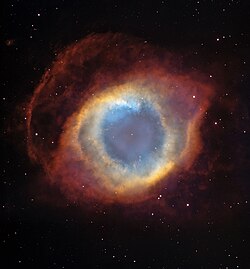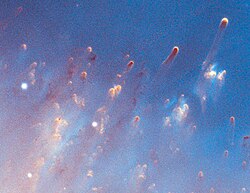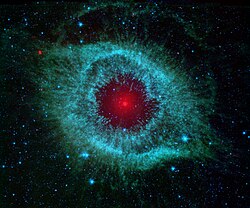Planetární mlhovina Helix
| Planetární mlhovina Helix | |
|---|---|
 Planetární mlhovina Helix (NGC 7293) na snímku z dalekohledu o průměru 2,2 m na observatoři La Silla. Autor: ESO. | |
| Pozorovací údaje (Ekvinokcium J2000,0) | |
| Typ | planetární mlhovina |
| Objevitel | Karl Ludwig Harding[1] |
| Datum objevu | 1824[1] |
| Rektascenze | 22h 29m 38,35s[2] |
| Deklinace | -20°50′13,64″[2] |
| Souhvězdí | Vodnář (lat. Aquarius) |
| Zdánlivá magnituda (V) | 7,3[1] |
| Úhlová velikost | 16´[3] |
| Vzdálenost | 450[3]/496[2]/714[4] ly |
| Fyzikální charakteristiky | |
| Poloměr | 2,87[5] ly |
| Označení v katalozích | |
| New General Catalogue | NGC 7293 |
| 2MASS | 2MASS J22293854-2050136 |
| IRAS | IRAS 22267-2102 a IRAS X2226-210 |
| Jiná označení | Helix Nebula, NGC 7293, PK36-57.1,[1] Caldwell 63 |
| (V) – měření provedena ve viditelném světle | |
| Některá data mohou pocházet z datové položky. | |
Planetární mlhovina Helix (NGC 7293, také známá jako Caldwell 63) je pravděpodobně nejbližší[6] a současně také nejjasnější planetární mlhovina na obloze.[7] Objevil ji Karl Ludwig Harding v roce 1824. Nalezneme ji v souhvězdí Vodnáře (Aquarius). Má zdánlivou jasnost 7,3m, úhlový rozměr jasné části 16´ a je od nás vzdálená přibližně 450 světelných let.[3] Svým tvarem se podobá Prstencové mlhovině a mlhovině Činka, přičemž mlhovina Činka má podobnou velikost a stáří, ale díváme se na ni pod jiným úhlem, a Prstencová mlhovina má velmi podobný vzhled, ale nachází se v mnohem větší vzdálenosti, je značně menší a mladší.[8]
Vlastnosti

Helix je příkladem planetární mlhoviny, kterou vytvořila středně až málo hmotná hvězda, která se na konci svého vývoje zbavila svých vnějších vrstev. Tento plynný obal při pohledu ze Země vypadá, jako bychom se dívali do šroubovice. Pozůstatek centrální hvězdy, neboli jádro planetární mlhoviny, se nyní stal bílým trpaslíkem a jeho zář je tak silná, že způsobuje jasnou fluorescenci dříve odvržených plynů.
V malém dalekohledu ji uvidíme jako mlhavý obláček, na fotografiích z velkých dalekohledů se však ukáže v plné kráse i se svou mateřskou hvězdou uprostřed. Tento bílý trpaslík zdánlivé jasnosti 13,3m s povrchovou teplotou 130 000 K je hvězda v závěrečném stadiu vývoje, která byla kdysi podobná Slunci.
V roce 2004 byl vydán snímek této mlhoviny složený ze snímků Hubbleova vesmírného dalekohledu a dalekohledu o průměru 0,9 m na observatoři Kitt Peak.[9]
Stavba
Předpokládá se, že mlhovina má tvar protáhlého sféroidu se silným zhuštěním směrem k plnému disku podél rovníkové plochy a hlavní poloosa sféroidu je od našeho úhlu pohledu odchýlená o 21° až 37°. Vnitřní disk má zdánlivý průměr 8×19' (0,52 pc), vnější prstenec má průměr 12×22' (0,77 pc) a nejkrajnější prstenec má průměr kolem 25' (1,76 pc). Nejkrajnější prstenec je na jedné straně zploštělý kvůli srážce s mezihvězdným prostředím.[5]
Skutečný průměr mlhoviny je kolem 5,7 světelného roku.[5] Rozpínání mlhoviny začalo asi před 12 100 lety odhozením svrchních vrstev mateřské hvězdy, což vytvořilo vnější prstenec, který se rozpíná rychlostí 32 km/s. Před 6 560 lety proběhlo druhé odhození, které vytvořilo vnitřní disk rozpínající se rychlostí 40 km/s. Nejkrajnější prstenec také pravděpodobně představuje samostatnou fázi odhození vrstev.[5]
Uzlíky

Helix byla první mlhovinou, ve které byly objeveny kometární uzlíky. Její hlavní prstenec obsahuje temné mlhoviny ve tvaru uzlíků a podobné byly následně objeveny i v dalších planetárních mlhovinách. Tyto uzlíky vykazují velkou symetrii směrem od centrální hvězdy a vypadají jako komety, protože mají jasné jádro (místní hranice fotoionizace) a ocasy, které míří směrem od centrální hvězdy. Jejich jádra ovšem mají rozměry několikanásobně větší než je oběžná dráha Pluta, i když je jejich hmotnost srovnatelná s hmotností Země.[10] Uzlíky jsou ve viditelném spektru neprůhledné kvůli Lymanovým fotonům z centrální hvězdy.[5][8] Počet těchto uzlíků v mlhovině Helix se odhaduje na více než 20 000.[11]
Excitační teplota je na různých místech mlhoviny různá.[11] Rotačně-vibrační teplota je v rozmezí 1 800 K v kometárních uzlících vnitřního disku (2,5' od centrální hvězdy) až přibližně 900 K ve vnějších oblastech vzdálených 5,6'.[11]
Galerie
- Planetární mlhovina Helix (NGC 7293) na snímku z dalekohledu o průměru 2,2 m na observatoři La Silla. Autor: ESO
- Infračervený snímek planetární mlhoviny Helix pořízený dalekohledem VISTA na observatoři Paranal v Chile
- Infračervený snímek planetární mlhoviny Helix pořízený Spitzerovým vesmírným dalekohledem.[12] Autor: NASA, JPL a K. Su (University of Arizona)
Reference
V tomto článku byl použit překlad textu z článku Helix Nebula na anglické Wikipedii.
- ↑ a b c d The NGC/IC Project: Results for NGC 7293 [online]. [cit. 2016-09-21]. Dostupné v archivu pořízeném dne 2009-05-28. (anglicky)
- ↑ a b c SIMBAD Astronomical Database: Results for NGC 7293 [online]. [cit. 2016-09-21]. Dostupné online. (anglicky)
- ↑ a b c SEDS NGC Catalog Online: Results for NGC 7293 [online]. [cit. 2016-09-21]. Dostupné online. (anglicky)
- ↑ Harris, Hugh C.; Dahn, Conard C.; Canzian, Blaise, et al. Trigonometric Parallaxes of Central Stars of Planetary Nebulae. S. 631–638. Astronomical Journal [online]. Únor 2007 [cit. 2016-09-23]. Roč. 133, čís. 2, s. 631–638. Dostupné online. arXiv astro-ph/0611543. doi:10.1086/510348. Bibcode 2007AJ....133..631H. (anglicky)
- ↑ a b c d e O'Dell, C. R.; McCullough, Peter R.; Meixner, Margaret. Unraveling the Helix Nebula: Its Structure and Knots. S. 2339–2356. Astronomical Journal [online]. Listopad 2004 [cit. 2016-09-23]. Roč. 128, čís. 5, s. 2339–2356. Dostupné online. doi:10.1086/424621. Bibcode 2004AJ....128.2339O. (anglicky)
- ↑ Hora, Joseph L.; Latter, William B.; Smith, Howard A., et al. Infrared Observations of the Helix Planetary Nebula. S. 426–441. Astrophysical Journal [online]. Listopad 2006 [cit. 2016-09-22]. Roč. 652, čís. 1, s. 426–441. Dostupné online. arXiv astro-ph/0607541. doi:10.1086/507944. Bibcode 2006ApJ...652..426H. (anglicky)
- ↑ Michal Kodriš. Průvodce hvězdnou oblohou: Vodnář [online]. [cit. 2016-09-22]. Dostupné online.
- ↑ a b O'Dell, C. R.; Balick, B.; Hajian, A. R., et al. Knots in Nearby Planetary Nebulae. S. 3329–3347. Astronomical Journal [online]. Červen 2002 [cit. 2016-09-22]. Roč. 123, čís. 6, s. 3329–3347. Dostupné online. doi:10.1086/340726. Bibcode 2002AJ....123.3329O. (anglicky)
- ↑ A New Twist on an Old Nebula [online]. hubblesite.org, 2004-12-16 [cit. 2016-09-22]. Dostupné online. (anglicky)
- ↑ NASA - APOD. Astronomický snímek dne: Podivné kometární uzlíky v mlhovině Helix [online]. astro.cz, 2008-04-13 [cit. 2016-09-23]. Dostupné online.
- ↑ a b c Matsuura, M.; Speck, A. K.; Smith, M. D., et al. VLT/near-infrared integral field spectrometer observations of molecular hydrogen lines in the knots of the planetary nebula NGC 7293 (the Helix Nebula). S. 1447–1459. Monthly Notices of the Royal Astronomical Society [online]. Prosinec 2007 [cit. 2016-09-23]. Roč. 382, čís. 4, s. 1447–1459. Dostupné online. arXiv 0709.3065. doi:10.1111/j.1365-2966.2007.12496.x. Bibcode 2007MNRAS.382.1447M.
- ↑ Su, K. Y. L.; Chu, Y.-H.; Rieke, G. H., et al. A Debris Disk around the Central Star of the Helix Nebula?. S. L41-L45. Astrophysical Journal [online]. Březen 2007 [cit. 2016-09-23]. Roč. 657, čís. 2, s. L41-L45. Dostupné online. arXiv astro-ph/0702296. doi:10.1086/513018. Bibcode 2007ApJ...657L..41S. (anglicky)
Související články
Externí odkazy
 Obrázky, zvuky či videa k tématu Planetární mlhovina Helix na Wikimedia Commons
Obrázky, zvuky či videa k tématu Planetární mlhovina Helix na Wikimedia Commons - Simbad – NGC 7293
Média použitá na této stránce
Autor: European Southern Observatory, Licence: CC BY 4.0
This colour-composite image of the Helix Nebula (NGC 7293) was created from images obtained using the the Wide Field Imager (WFI), an astronomical camera attached to the 2.2-metre Max-Planck Society/ESO telescope at the La Silla observatory in Chile. The blue-green glow in the centre of the Helix comes from oxygen atoms shining under effects of the intense ultraviolet radiation of the 120 000 degree Celsius central star and the hot gas. Further out from the star and beyond the ring of knots, the red colour from hydrogen and nitrogen is more prominent. A careful look at the central part of this object reveals not only the knots, but also many remote galaxies seen right through the thinly spread glowing gas. This image was created from images through blue, green and red filters and the total exposure times were 12 minutes, 9 minutes and 7 minutes respectively.
This infrared image from NASA's Spitzer Space Telescope shows the Helix Nebula, a cosmic starlet often photographed by amateur astronomers for its vivid colors and eerie resemblance to a giant eye.
The nebula, located about 700 light-years away in the constellation Aquarius, belongs to a class of objects called planetary nebulae. Discovered in the 18th century, these colorful beauties were named for their resemblance to gas-giant planets like Jupiter.
Planetary nebulae are the remains of stars that once looked a lot like our sun. When sun-like stars die, they puff out their outer gaseous layers. These layers are heated by the hot core of the dead star, called a white dwarf, and shine with infrared and visible colors. Our own sun will blossom into a planetary nebula when it dies in about five billion years.
In Spitzer's infrared view of the Helix nebula, the eye looks more like that of a green monster's. Infrared light from the outer gaseous layers is represented in blues and greens. The white dwarf is visible as a tiny white dot in the center of the picture. The red color in the middle of the eye denotes the final layers of gas blown out when the star died.
The brighter red circle in the very center is the glow of a dusty disk circling the white dwarf (the disk itself is too small to be resolved). This dust, discovered by Spitzer's infrared heat-seeking vision, was most likely kicked up by comets that survived the death of their star. Before the star died, its comets and possibly planets would have orbited the star in an orderly fashion. But when the star blew off its outer layers, the icy bodies and outer planets would have been tossed about and into each other, resulting in an ongoing cosmic dust storm. Any inner planets in the system would have burned up or been swallowed as their dying star expanded.
So far, the Helix nebula is one of only a few dead-star systems in which evidence for comet survivors has been found.
This image is made up of data from Spitzer's infrared array camera and multiband imaging photometer. Blue shows infrared light of 3.6 to 4.5 microns; green shows infrared light of 5.8 to 8 microns; and red shows infrared light of 24 microns.In one of the largest and most detailed celestial images ever made, the coil-shaped Helix Nebula is being unveiled tomorrow in celebration of Astronomy Day (Saturday, May 10).
The composite picture is a seamless blend of ultra-sharp NASA Hubble Space Telescope (HST) images combined with the wide view of the Mosaic Camera on the National Science Foundation's 0.9-meter telescope at Kitt Peak National Observatory, part of the National Optical Astronomy Observatory, near Tucson, Ariz. Astronomers at the Space Telescope Science Institute assembled these images into a mosaic. The mosaic was then blended with a wider photograph taken by the Mosaic Camera. The image shows a fine web of filamentary "bicycle-spoke" features embedded in the colorful red and blue gas ring, which is one of the nearest planetary nebulae to Earth.
Because the nebula is nearby, it appears as nearly one-half the diameter of the full Moon. This required HST astronomers to take several exposures with the Advanced Camera for Surveys to capture most of the Helix. HST views were then blended with a wider photo taken by the Mosaic Camera. The portrait offers a dizzying look down what is actually a trillion-mile-long tunnel of glowing gases. The fluorescing tube is pointed nearly directly at Earth, so it looks more like a bubble than a cylinder. A forest of thousands of comet-like filaments, embedded along the inner rim of the nebula, points back toward the central star, which is a small, super-hot white dwarf.
The tentacles formed when a hot "stellar wind" of gas plowed into colder shells of dust and gas ejected previously by the doomed star. Ground-based telescopes have seen these comet-like filaments for decades, but never before in such detail. The filaments may actually lie in a disk encircling the hot star, like a collar. The radiant tie-die colors correspond to glowing oxygen (blue) and hydrogen and nitrogen (red).
Valuable Hubble observing time became available during the November 2002 Leonid meteor storm. To protect the spacecraft, including HST's precise mirror, controllers turned the aft end into the direction of the meteor stream for about half a day. Fortunately, the Helix Nebula was almost exactly in the opposite direction of the meteor stream, so Hubble used nine orbits to photograph the nebula while it waited out the storm. To capture the sprawling nebula, Hubble had to take nine separate snapshots.
Planetary nebulae like the Helix are sculpted late in a Sun-like star's life by a torrential gush of gases escaping from the dying star. They have nothing to do with planet formation, but got their name because they look like planetary disks when viewed through a small telescope. With higher magnification, the classic "donut-hole" in the middle of a planetary nebula can be resolved. Based on the nebula's distance of 650 light-years, its angular size corresponds to a huge ring with a diameter of nearly 3 light-years. That's approximately three-quarters of the distance between our Sun and the nearest star.
The Helix Nebula is a popular target of amateur astronomers and can be seen with binoculars as a ghostly, greenish cloud in the constellation Aquarius. Larger amateur telescopes can resolve the ring-shaped nebula, but only the largest ground-based telescopes can resolve the radial streaks. After careful analysis, astronomers concluded the nebula really isn't a bubble, but is a cylinder that happens to be pointed toward Earth.Autor: ESO/VISTA/J. Emerson, Licence: CC BY 4.0
ESO's Visible and Infrared Survey Telescope for Astronomy (VISTA) has captured this unusual view of the Helix Nebula (NGC 7293), a planetary nebula located 700 light-years away. The coloured picture was created from images taken through Y, J and K infrared filters. While bringing to light a rich background of stars and galaxies, the telescope's infrared vision also reveals strands of cold nebular gas that are mostly obscured in visible images of the Helix.
Autor: ESO/VISTA/J. Emerson/S. Brunier/A. Fujjii/Digitized Sky Survey 2 Acknowledgment: Cambridge Astronomical Survey Unit Music: John Dyson (from the album Moonwind), Licence: CC BY 4.0
This zoom sequence starts with a wide-field view of the rather empty region of sky around the constellation of Aquarius. As we close in we can see the faint ring shape of the Helix Nebula (NGC 7293), one of the closest planetary nebulae to the Earth. In the final sequence we see a new image of the Helix taken in infrared light with the VISTA telescope at ESO's Paranal Observatory in Chile.
Autor: ESO/VISTA/J. Emerson. Acknowledgment: Cambridge Astronomical Survey Unit, Licence: CC BY 4.0
This video compares a new view of the Helix Nebula acquired with the VISTA telescope in infrared light with the more familiar view in visible light from the MPG/ESO 2.2-metre telescope at ESO's La Silla Observatory. The infrared vision of VISTA reveals strands of cold nebular gas that are mostly obscured in visible light images of the Helix.
Close-Up of the Helix Nebula
The Helix Nebula: a Gaseous Envelope Expelled By a Dying Star
- About the Object
- Object Name: Helix Nebula, NGC 7293 or "The Eye of God"
- Object Description: Planetary Nebula
- Position (J2000): R.A. 22h 29m 48.20s
- Dec. -20° 49' 26.0"
- Constellation: Aquarius
- Distance: About 690 light-years (213 parsecs)
- Dimensions: The image is roughly 28.7 arcminutes (5.6 light-years or 1.7 parsecs) across.
- About the Data
- Instruments: ACS/WFC on Hubble Space Telescope (HST) and Mosaic II Camera on CTIO 4m telescope
- Exposure Time: 4.5 hours (HST) and 10 minutes (CTIO)
- Filters: F502N ([O III]) and F658N (Ha) (for the HST); c6009 (H alpha)and kc6014 ([O III]) for the CTIO
- Image properties
- Centered on white dwarfed and cropped
- Downsampled to 3200x3200
- Saved as jpg, quality 8/10, 5 scans
- Stitching errors manually fixed



![Infračervený snímek planetární mlhoviny Helix pořízený Spitzerovým vesmírným dalekohledem.[12] Autor: NASA, JPL a K. Su (University of Arizona)](http://upload.wikimedia.org/wikipedia/commons/thumb/7/7f/Comets_Kick_up_Dust_in_Helix_Nebula_%28PIA09178%29.jpg/250px-Comets_Kick_up_Dust_in_Helix_Nebula_%28PIA09178%29.jpg)







